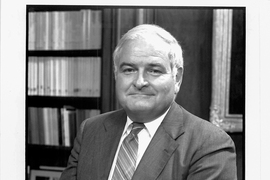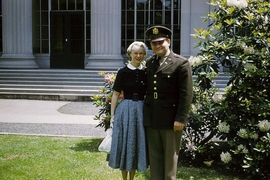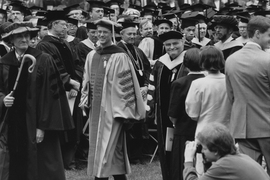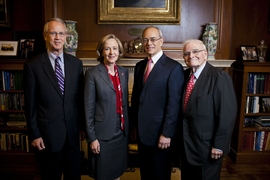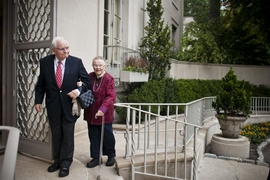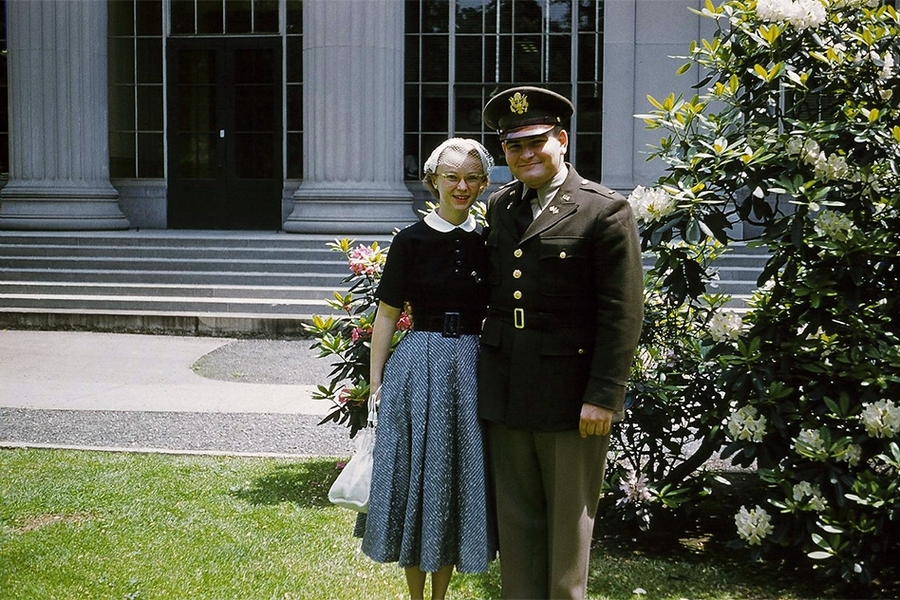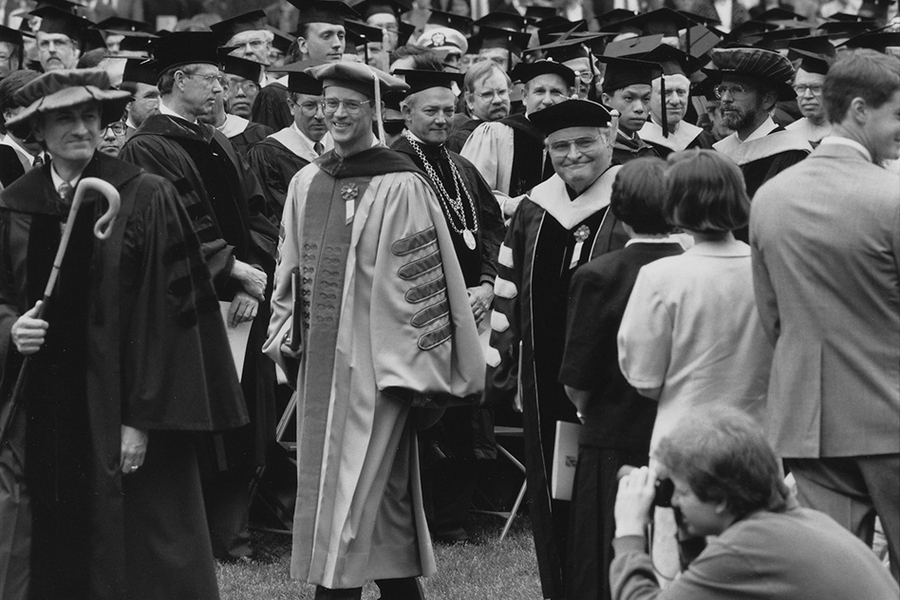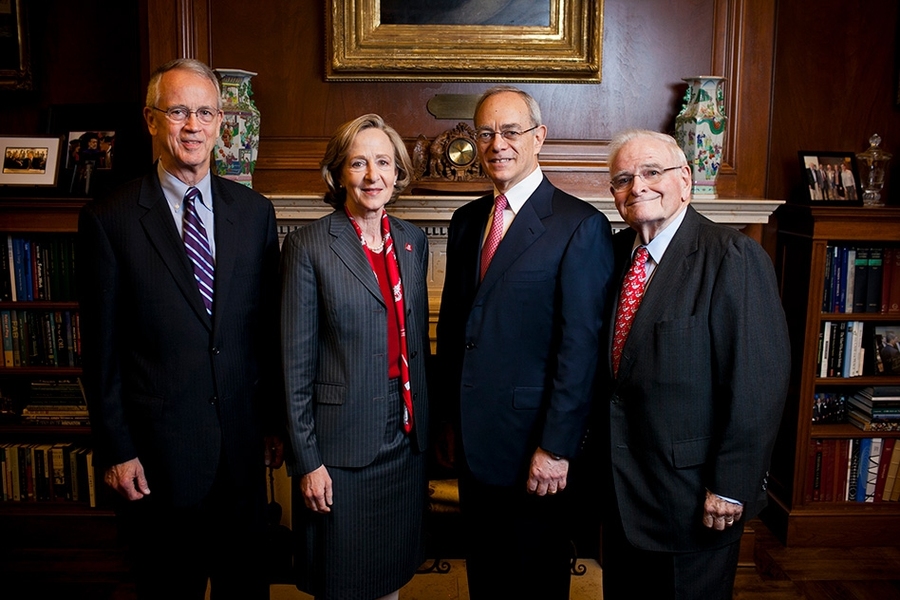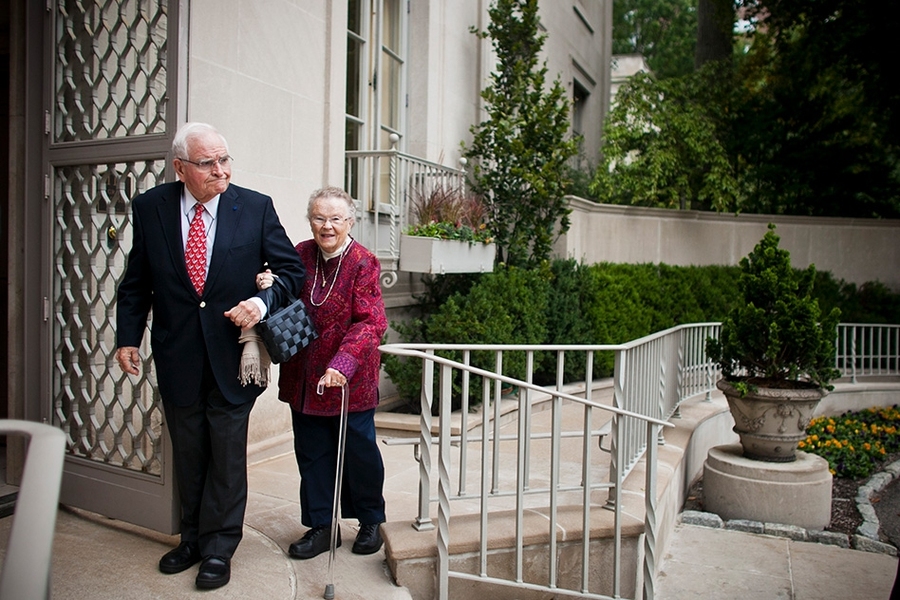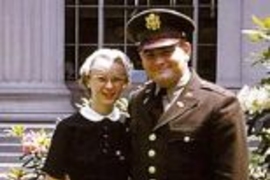Paul Gray ’54, SM ’55, ScD ’60, a devoted leader at MIT whose lifetime career at the Institute included turns as a student, professor, dean of engineering, associate provost, chancellor, president, and MIT Corporation chair, died today at his home in Concord, Massachusetts, after a lengthy battle with Alzheimer’s disease. He was 85.
As MIT’s 14th president, from 1980 to 1990, and in his other roles, Gray transformed the Institute through his commitment to enhancing undergraduate education and increasing the presence of women and underrepresented minorities on campus. With his wife, Priscilla King Gray, at his side, he helped guide MIT through the social change and technological transformation that marked the second half of the 20th century.
His commitment to MIT, particularly to its students, was absolute. Even after retiring as MIT Corporation chair in 1997, he returned to teaching and advising. His work at the Institute was carried out in partnership with Priscilla, a champion of public service who led efforts to create a sense of community at MIT and co-founded what is now called the Priscilla King Gray Public Service Center.
“Paul Gray led MIT with the clear-eyed pragmatism and uncommon steadiness of a born engineer, and the humility, warmth, and wisdom of an exceptional human being,” says MIT President L. Rafael Reif. “He was an indispensable advisor to two MIT presidents who preceded him and all three who have followed him. His affection for and trust in our students allowed him to serve as an anchor at MIT during the turbulence of the Vietnam War; inspired him to greatly increase the presence and profile of underrepresented minority and women students in our community; and led him to pioneer the creation of the then-revolutionary Undergraduate Research Opportunities Program, now an inseparable part of the MIT experience. Paul loved the MIT community like family — and we feel his loss like family, too.”
“Paul became my first and most essential guide to MIT. With the wisdom gained from a lifetime devoted to the Institute, he showed me MIT’s ethos and history,” says MIT President Emerita Susan Hockfield, who served as president of the Institute from 2004 to 2012. “Whether at dinner with his newly red-coated Class of ’54 classmates, or walking the Infinite Corridor with wonderful Priscilla — love of his life and partner in a presidency of warmth and purpose — his love of the place, of the people, and of our mission shone brightly in all he said and did. A part of me has always and will always see MIT through his eyes.”
A vigorous embrace of diversity
When Gray arrived at MIT as an undergraduate, women made up less than 2 percent of each MIT class, and the percentage of underrepresented minorities was similarly low. After joining the administration, he took up the charge to make the MIT community more representative of society at large.
In 1968, in response to recommendations from the newly created Black Students Union, Gray, who was then associate provost, and others created the Task Force on Educational Opportunity. Among other efforts, they hired an assistant director of admissions and worked with him to actively recruit minority students. MIT also began the landmark summer program Project Interphase, staffed largely by students of color.
As chancellor, Gray wrote and began implementing the Institute’s first formal plan to increase the presence of women and minorities among MIT’s faculty as well as its student body. In a 2008 MIT Infinite History interview, Gray recalled that these efforts represented a sea change for the Institute. Until that time, “MIT had never recruited [any students]. We waited for applications to come,” he said.
By the time he stepped down from the presidency in 1990, women made up more than 30 percent of incoming undergraduate classes, and underrepresented minorities constituted 14 percent. Gray’s efforts had laid the foundation for MIT’s subsequent leaders to further increase diversity and inclusion at the Institute. His work on diversity among students and the faculty “may be the most important thing I did around here,” Gray said in the Infinite History interview.
One of the first members of the Black Students Union was Shirley Ann Jackson ’68, PhD ’73, who is now the president of Rensselaer Polytechnic Institute and a life member of the MIT Corporation. “For me, Paul was foremost a great friend, advisor, supporter, and confidante. I always turned to him at critical junctures in my career. He never failed me — his advice and guidance were always spot on,” Jackson says.
Reshaping undergraduate education
Even after becoming a full-time administrator in the 1970s, Gray maintained a close connection with the Institute’s students. He earned his bachelor’s, master’s, and doctoral degrees from MIT, all in electrical engineering, in 1954, 1955, and 1960, respectively. After three years of teaching as an instructor, he joined the faculty in 1960 and became the MIT Class of 1922 Professor of Electrical Engineering from 1968 to 1971. He was associate dean for student affairs from 1965 to 1967, associate provost from 1969 to 1970, and dean of the School of Engineering from 1970 to 1971.
“To me, he is the iconic president of MIT because he was made out of pure Institute clay, as an undergraduate, graduate, professor, and academic leader,” says Institute Professor Emeritus John Deutch, who served as MIT provost from 1985 to 1990. “As his provost, I witnessed his endless devotion to education and scholarship. His love for Priscilla and his family matched his love for MIT.”
In his Infinite History interview, Gray reflected on his early days of teaching, which he did alongside Harold “Doc” Edgerton, another popular MIT professor: “I found it enormously satisfying. Demanding, but very satisfying. And somewhere in that two-year interval, with teaching every semester, I came to the conclusion that this is what I want to do with my life.”
As a professor, Gray was part of an effort in the 1960s to overhaul the way electrical engineering was taught, moving the focus away from vacuum tubes and squarely onto semiconductor electronics. In support of this transition, Gray wrote seven textbooks and other materials, working with MIT colleagues as well as others at Stanford University, the University of California at Berkeley, Raytheon, and IBM.
Gray joined the MIT administration full-time when he accepted the position of chancellor, serving from 1971 to 1980, followed by a decade as MIT president. He was chairman of the MIT Corporation from 1991 to 1997.
As associate provost, Gray championed professor Margaret MacVicar SB '64, ScD '67 and her innovative proposal to create a program that would involve undergraduates in faculty research. The result was the Undergraduate Research Opportunities Program (UROP), one of the earliest programs of its kind in the United States and now a national model, supporting thousands of projects each year. Today, 90 percent of MIT graduating seniors participate in at least one UROP during their undergraduate years.
As president, Gray committed himself to paying renewed attention to the “pace, coherence, and intellectual impact” of the undergraduate experience.
To this end, he helped make a number of reforms to MIT’s undergraduate curriculum. He reaffirmed the pass/no record grading system for freshman that he had helped implement while associate provost. He also launched a formal review of an undergraduate curriculum that until then had been largely focused on engineering, mathematics, and the physical sciences. This led to the addition of biology to the core requirements, as well as a strengthening of the offerings in the humanities and social sciences.
“There may be no single person in modern history who has had such an impact on MIT as Paul Gray,” says MIT Corporation Life Member Emeritus Jim Champy ’63, SM ’65. “So much of what we experience at MIT today was begun by Paul. I worked for him in my years at MIT while he was chancellor, and knew him later as a friend and Corporation member. For all the magnitude of his impact, Paul — together with Priscilla — brought a genuine warmth and caring for every student and member of the MIT community.”
Responding to national and international trends
In broadening the MIT curriculum, Gray was also carrying out another of his goals: to rededicate science and technology as socially powerful activities.
“We continue to hear the complaint that … many of our human and social ills are the direct result of unanticipated and deleterious artifacts of technology, foisted upon the world by technicians with tunnel vision,” he said in his inaugural address.
“It is clear, however, that the future development not only of this nation, but of the world, is inexorably tied to continued scientific progress and to the humane and thoughtful applications of science,” Gray continued. “What is needed is not a retreat from science and technology, but a more complete science and technology. We must strive to develop among ourselves, among our students, and in the public at large, an understanding of the fact that engineering and science are, by their very nature, humanistic enterprises.”
Gray furthered his vision of a science and engineering enterprise in service of society while developing new ventures at MIT and representing the Institute in Washington.
In 1986, with the economic recessions of the 1970s and early 1980s still a recent memory, MIT under Gray’s leadership created the Commission on Industrial Productivity. The group, which comprised 17 MIT faculty members, produced the landmark study “Made in America: Regaining the Productive Edge,” which examined the causes of the recent slowdown in U.S. productivity growth and made recommendations for improved economic performance.
Gray also helped establish the Leaders for Manufacturing Program (now Leaders for Global Operations), a joint effort by the MIT Sloan School of Management and the School of Engineering in partnership with top manufacturing companies. The program’s goal was to help students develop the technical, analytical, and business skills needed to lead strategic initiatives in high-tech, operations, and manufacturing companies.
Also during his presidency, Gray implemented a plan to establish the Whitehead Institute for Biomedical Research at MIT. Initially headed by MIT Professor David Baltimore, the institute brought major new biology resources to MIT.
Gray served for four years on the White House Science Council and the Council’s Panel on the Health of Universities. He was also vice chairman of the nonprofit Council on Competiveness. He was a staunch advocate for public understanding of science, federal support for research and higher education, and collaboration between academia and industry.
Increasing MIT’s financial strength
Federal funding for science and technology research and for higher education had been at a historic high during the Sputnik era, but it declined significantly in the 1970s and remained stagnant in the ’80s, during Gray’s term as president.
In 1987, MIT under Gray launched the five-year Campaign for the Future, which raised $710 million. And in 1994, while at the helm of the MIT Corporation, Gray played a lead role in the seven-year Campaign for MIT, which raised $2.05 billion, surpassing the original goal of $1.5 billion and bringing the Institute into a small group of universities — many with significantly larger alumni populations — that had comparably ambitious campaign goals. By the time Gray retired from the Corporation in 1997, MIT’s endowment was more than $2.1 billion.
Gray also helped MIT secure funding from corporations in Japan, South Korea, and Taiwan, and created long-term partnerships with industry that provided relatively unconstrained support for MIT research.
Much of Gray’s success in the fundraising arena can be credited to the personable approach both he and his wife brought to MIT.
Many alumni have recalled the care the couple demonstrated toward MIT students. Together, the pair held weekly dinners for seniors in the president’s house — now known as Gray House — and visited dormitories and other student residences. They were often seen together on campus, talking with students, faculty, and staff from across the MIT community.
“In the whole history of MIT, very few people have ever rivaled Paul Gray’s legacy of stewardship and service — as a faculty member, an administrator, an alumnus, a trustee, and a leader,” says Robert Millard ’73, chair of the MIT Corporation. “His nearly 50 years on the MIT Corporation included 26 as a member of the Executive Committee and, after his presidency, seven distinguished years as Corporation Chair. He played a pivotal role in countless key decisions, including the selection of MIT’s two most recent presidents. Universally respected and loved, Paul was — and remains — an inspiration to all of us charged with caring for what he called ‘this special place.’”
Family at the center of life
Paul Edward Gray was born on Feb. 7, 1932, in Newark, New Jersey. He cited his father, a technician at a public utility who never finished high school, as an influential figure who helped him discover his interest in electricity at an early age. By first or second grade, Gray was winding copper wire around nails to make electromagnets, and by age 10 he was repairing his neighbors’ radios. He built his own radio equipment and was a ham radio operator for many years.
By high school, Gray knew he wanted to be an engineer. As an undergraduate at MIT, he joined the Phi Sigma Kappa fraternity, enrolled in ROTC, and met Priscilla on a blind date. After earning his master’s degree and marrying Priscilla in 1955, he served in the U.S. Army for two years, then returned to MIT for further graduate study. Together, the Grays raised and educated four children. In his spare time, Gray played squash, made furniture in his woodshop, and enjoyed many outdoor activities with his family.
Gray served on the board of directors of the Boeing Company and Eastman Kodak Company, and was a Life Trustee of the Boston Museum of Science and Wheaton College. He was a life fellow of the Institute of Electrical and Electronics Engineers, and a member of the National Academy of Engineering.
Gray is survived by his wife, Priscilla King Gray; by four children and their spouses — Virginia and Thomas Army, Amy and David Sluyter, Andrew and Yukiko Gray, and Louise and Timothy Huyck — and by 12 grandchildren, three of their spouses, and one great grandchild. He also leaves a sister-in-law and brother-in-law, Cynthia and Louis Schueler, and several nephews and nieces.
Gifts in Gray’s memory may be made to MIT’s Aging Brain Initiative to support research on Alzheimer’s disease. A memorial service will be held at Hancock United Church of Christ in Lexington on Oct. 1. An MIT memorial service is planned for 3:00 p.m. on Thursday, Nov. 30, in Kresge Auditorium.
